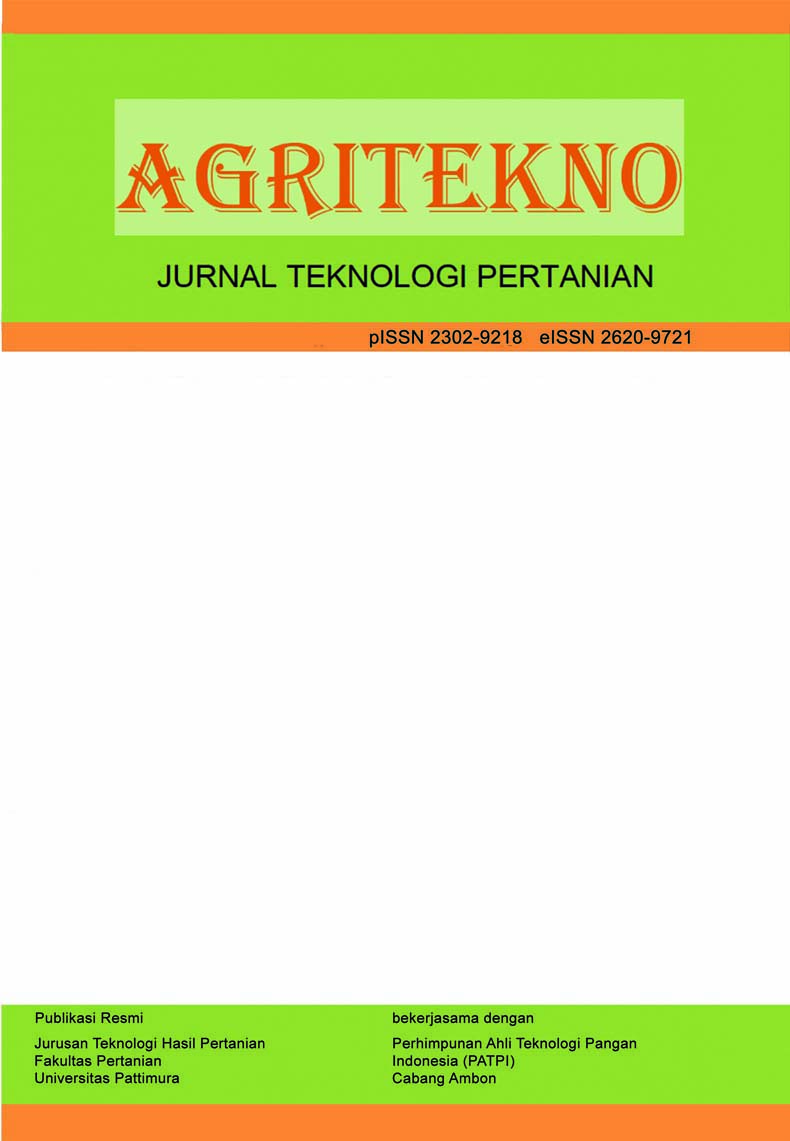Pembuatan Kopi Excelsa (Coffea liberica var. Dewerei.) Wine dengan Variasi Tingkat Roasting dan Lama Fermentasi
Making A Excelsa (Coffea Liberica Var. Dewerei.) Wine Coffee With Variation Of Roasting Levels And Fermentation Duration
Abstract
Wine coffee is produced through an extended fermentation process, during which the intensity of its flavor and aroma increases. The coffee variety used in this study is excelsa, known for its naturally sour profile and strong aroma, characterized by a unique combination of sour, sweet, and astringent flavors. The objectives of this study were to determine the effects of fermentation duration and roasting level on the alcohol content of excelsa wine coffee and to determine its sensory attributes. The study employed a Randomized Complete Block Design with two factors: fermentation duration (factor X) and roasting level (factor Y). The parameters analyzed included moisture content, ash content, caffeine content, alcohol content, and organoleptic test, which includes preference for color, aroma, and taste of the excelsa wine coffee brew. From the results of this study, it was found that the water content, ash content, caffeine content, alcohol content, and sensory evaluation (color, aroma, and taste preference) of the excelsa wine coffee brew. The results showed that moisture, ash, and caffeine contents met the specified quality standards. The best sensory results were obtained from samples fermented for 30 days and roasted at a medium level, producing a well-balanced taste, neither overly sour nor predominantly bitter.
Downloads
References
Awwad, S., Issa, R., Alnsour, L., Albals, D., & Al-momani, I. (2021). Quantification of caffeine and chlorogenic acid in green and roasted coffee samples using HPLC-DAD and evaluation of the effect of degree of roasting on their levels. Molecules, 26(7502), 2–9. https://doi.org/10.3390/molecules26247502
Azmi, N., Juanda, Satriana, Yusfa, & Abubakar. (2022). Tingkat kesukaan konsumen terhadap kopi wine gayo pada beberapa derajat penyangraian. Jurnal Ilmiah Mahasiswa Pertanian, 7(2), 324–329. https://doi.org/10.17969/jimfp.v7i2.19886
Budiyanto, B., Uker, D., & Izahar, T. (2021). Karakteristik fisik kualitas biji kopi dan kualitas kopi bubuk Sintaro 2 dan Sintaro 3 dengan berbagai tingkat sangrai. Jurnal Agroindustri, 11(1), 54–71. https://doi.org/10.31186/j.agroindustri.11.1.54-71
Diviš, P., Pořízka, J., & Kříkala, J. (2019). The effect of coffee beans roasting on its chemical composition. Potravinarstvo Slovak Journal of Food Sciences, 13(1), 344–350. https://doi.org/10.5219/1062
Farhan, M. (2019) Pengaruh metode pengolahan pasca panen dan teknik penyeduhan terhadap cita rasa kopi. Sarjana Thesis, Fakultas Teknologi Pertanian. Universitas Brawijaya.
Furqon, M., Farikha Azizah, I., & Rahayuningtyas, A. (2023). Fluidization type roasting machine performance test on the quality characteristics of coffee beans. Prosiding seminar nasional UNIMUS, 6, 1007–1018.
Hariyadi, T., Rispiandi, Abdulloh, S.H., & Manfaati, R. (2024). Pengaruh konsentrasi mikroorganisme lokal pada fermentasi biji kopi arabika menggunakan fermentor skala pilot plant. Jurnal Rekayasa Proses, 18(1), 26–33. https://doi.org/10.22146/jrekpros.86718
Harmawan, T., Azhari, M. F., & Yusak, Y. (2019). Penentuan kadar alkohol pada air nira aren di Kecamatan Namorambe Kabupaten Deli Serdang berdasarkan lama waktu penyimpanan pada suhu ruang dengan metode gravimetri. Quimica: Jurnal Kimia Sains dan Terapan, 1(2), 12–14.
Kiefer, C., Schwarz, S., Rohn, S., & Weller, P. (2023). The aromatic fingerprint of fermented Coffea liberica. Proceedings of International Coffee Convention 2023, 89(4), 4. https://doi.org/10.3390/icc2023-14838
Laukalja, I., Kruma, Z., & Cinkmanis, I. (2022). Impact of the roast level on chemical composition of coffee from Colombia. Proceedings of the Latvian Academy of Sciences, 76(1), 145–151. https://doi.org/10.2478/prolas-2022-0022
Mardjan, S.S., Heri Purwanto, E., & Yoga Pratama, G. (2022). Pengaruh suhu awal dan derajat penyangraian terhadap sifat fisikokimia dan citarasa kopi Arabika Solok. Jurnal Keteknikan Pertanian, 10(2), 108–122. https://doi.org/10.19028/jtep.010.2.108-122
Muzaifa, M., Abubakar, Y., Nilda, C., Andini, R., Olivia, B., & Putri, A.N. (2023). Physicochemical and sensory characteristics of three types of wine coffees from Bener Meriah Regency, Aceh Indonesia. IOP Conference Series: Earth and Environmental Science, 1183, 1–8. https://doi.org/10.1088/1755-1315/1183/1/012061
Natan, N.A.T., Rollando, Afthoni, M.H., & Yuniati, Y. (2023). Peningkatan kontrol kualitas kopi Robusta Coffea Canephora fermentasi Desa Kucur dengan optimasi level roasting. Sainsbertek Jurnal Ilmiah Sains & Teknologi, 3(2), 78–84. https://doi.org/10.33479/sb.v3i2.230
Purnawan, R.B., Bimantio, M.P., & Ulfah, M. (2025). Pembuatan serbuk minuman fungsional dengan variasi perbandingan kopi arabika honey dan kopi pinang muda dengan penambahan ekstrak gambir (Ucaria gambir Roxb). Jurnal Teknologi Pangan dan Gizi, 24(1), 22–30. https://doi.org/10.33508/jtpg.v24i1.5797
Putri, A., Darma, E.C.G., & Saadiyah, R.E. (2019). Pembuatan serbuk kopi fermentasi dengan penambahan Saccharomyces cerevisiae dan metode “Three-Piece-Water-Filled Cup Airlock System”. Prosiding Farmasi, 5(2), 518–526.
Ramadhan, R.L., Prihatiningtyas, R., & Maligan, J.M. (2022). Karakteristik sensoris wine coffee dan natural coffee Arabika Ampelgading. Jurnal Pangan dan Agroindustri, 10(4), 235–239. https://doi.org/10.21776/ub.jpa.2022.010.04.6
Rosadi, M.I., Majid, A., Rizal, A., Ulum, B., Asror, K., Fu’ad, M., Prayogi, D., & Dhani, Y. A. (2021). Pengolahan kopi Excelsa pasca panen terhadap roasting kopi di Kelurahan Pecalukan Kecamatan Prigen Kabupaten Pasuruan. Jurnal Abdimas Berdaya, 4(02), 152–158. https://doi.org/10.30736/jab.v4i02.134
Sastrawan, I.P.A., Duniaji, A.S., & Wisaniyasa, N.W. (2022). Pengaruh konsentrasi sukrosa terhadap karakteristik wine kopi arabika Kintamani. Jurnal Ilmu dan Teknologi Pangan (ITEPA), 11(3), 461. https://doi.org/10.24843/itepa.2022.v11.i03.p07
Sihombing, R.R.R., Priyono, S., & Hartanti, L. (2023). The effect of exselsa coffee roasting temperature and time on the physicochemical and sensory properties of coffee powder. FoodTech: Jurnal Teknologi Pangan, 6(1), 1–12. https://doi.org/10.26418/jft.v6i1.65999
Wardhana, M.G. & Irwan, M.S. (2020). Analisis karakteristik kandungan Kopi Bening (Clear Coffee) Kabupaten Banyuwangi. Jurnal Agrotek Ummat, 7(2), 65. https://doi.org/10.31764/jau.v7i2.2956
Winarno, R.A., Perangin-Angin, M.I.B., & Sembiring, N.V. (2021). Karakteristik sifat kimia biji kopi arabika dengan beberapa metoda pengolahan di Kabupaten Simalungun Provinsi Sumatera Utara. Agrivet : Jurnal Ilmu-Ilmu Pertanian dan Peternakan, 9(2), 237–243. https://doi.org/10.31949/agrivet.v9i2.1701
Copyright (c) 2025 The Author(s)

This work is licensed under a Creative Commons Attribution-ShareAlike 4.0 International License.
Authors who publish with this journal agree to the following terms:
- Authors retain copyright and grant the journal the right of first publication with the work simultaneously licensed under a Creative Commons Attribution License that allows others to share the work with an acknowledgement of the work's authorship and initial publication in this journal.
- Authors are able to enter into separate, additional contractual arrangements for the non-exclusive distribution of the journal's published version of the work (e.g., post it to an institutional repository or publish it in a book), with an acknowledgement of its initial publication in this journal.
- Authors are permitted and encouraged to post their work online (e.g., in institutional repositories or on their website) prior to and during the submission process, as it can lead to productive exchanges, as well as earlier and greater citation of published work (See The Effect of Open Access).









